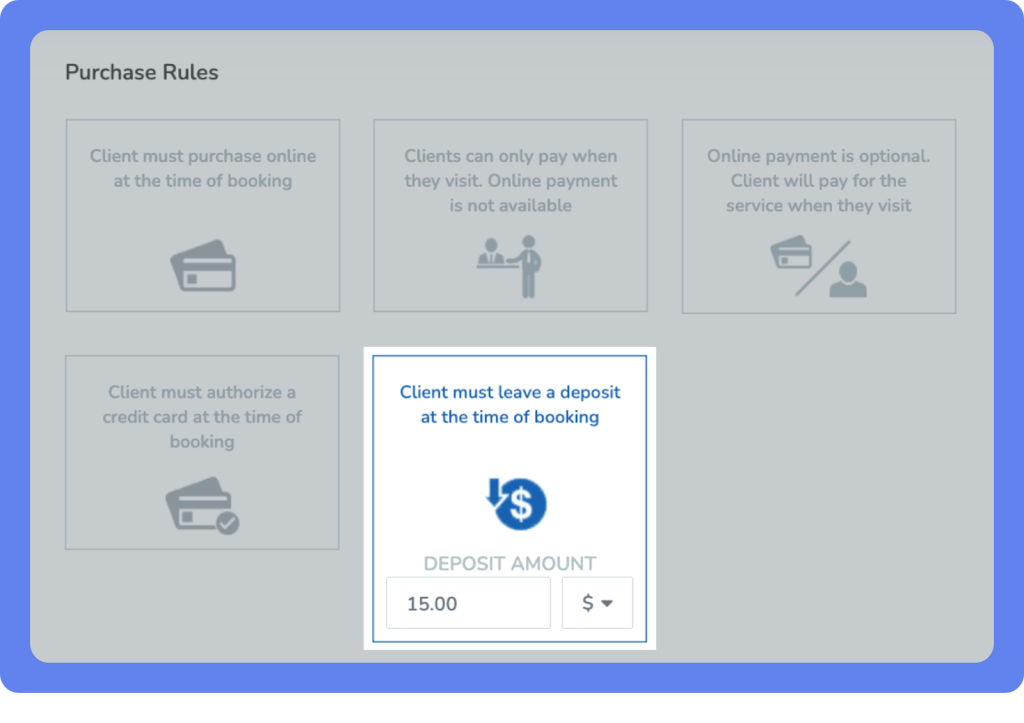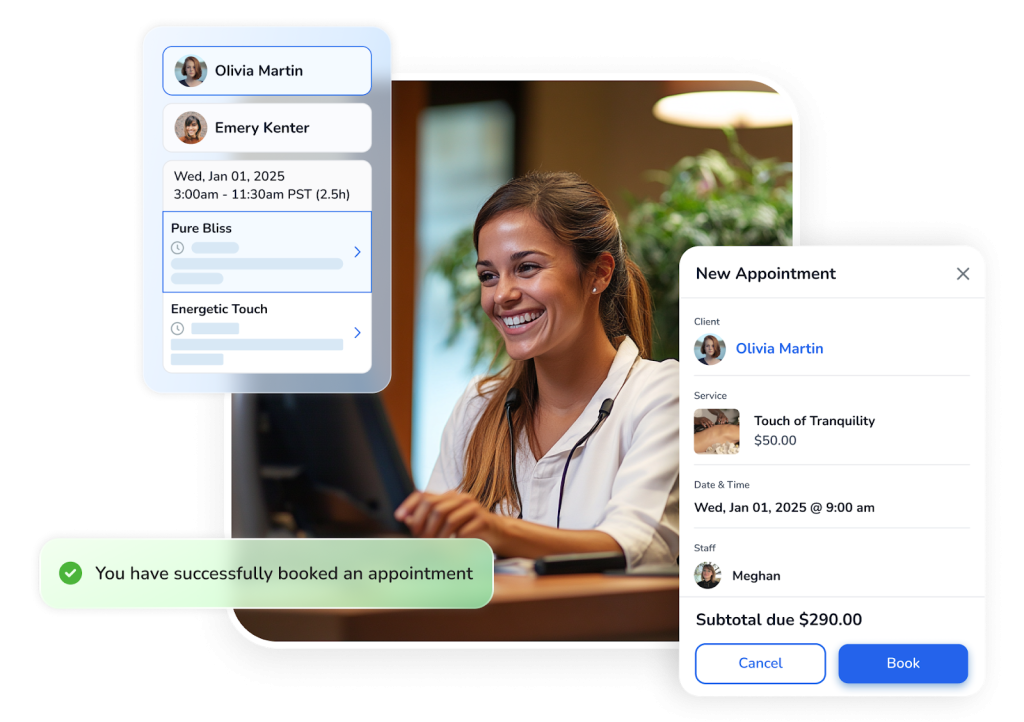10 Best Massage Therapy Software Solutions for 2026

Last Updated on 3 September, 2025
From mobile therapists to multi-location franchises, the right massage therapy software turns time-consuming admin into scalable growth. These platforms do more than keep the calendar organized. They also shape the client experience, protect sensitive records, and give therapists back the time they need to focus on care instead of paperwork.
In this guide, we’ll rank the 10 best massage therapy software solutions for 2026, highlight the features that matter most, and show massage clinic owners how the right software choice can drive revenue, improve retention, and support long-term growth.
Key Takeaways – Massage Therapy Software 2026
- Purpose-built massage software helps clinics grow by streamlining booking, compliance, and marketing.
- Automated reminders, deposits, and online scheduling reduce no-shows and keep calendars full.
- SOAP note tools and secure records protect therapists while meeting health data requirements.
- Choosing the right platform depends on your model, from solo practitioners to large franchises.
Why 2026 Demands Purpose-Built Massage Software
Massage businesses are facing a different landscape in 2026. Clients expect online booking at their fingertips. Health data regulations are tighter than ever. And competition isn’t just from the studio down the street—it’s from mobile therapists, corporate wellness programs, and full-service franchises.
The stakes are higher too: the global spa services market was valued at $96.5 billion in 2024 and is projected to hit $147.1 billion by 2030, with massage therapies making up almost 40% of that growth (Grand View Research).
In such a rapidly expanding market, generic scheduling apps can’t keep up.
Purpose-built massage therapy software helps owners manage compliance, keep better records, market effectively, and most importantly, book more sessions without adding more admin hours to the day.
Book More Sessions with the Best Massage Scheduling Software
Clients want easy, flexible ways to book. The best massage therapy software offer:
- 24/7 online booking synced across desktop and mobile
- Automated waitlists so no slot goes to waste
- Smart staff assignment that matches client preferences and therapist availability
When clients can self-book, they’re more likely to commit. And when your calendar stays full, revenue follows. For a deeper breakdown of must-have features, check out this guide to massage scheduling software tools.
Slash No-Shows via Automated Reminders & Deposits
Every missed session is lost income. Top massage therapy software solutions integrate reminders via text, email, or push notifications. Some even let you require deposits or pre-payments, which cuts down on cancellations.
For example, WellnessLiving clients often set up automated reminders paired with small deposits. Owners report a sharp drop in no-shows, freeing up more hours for paying appointments instead of chasing down late clients.

WellnessLiving allows for deposits at the time of booking
Keep SOAP Notes & Compliance in One Place
For massage therapists, proper documentation isn’t optional. SOAP notes protect both the practitioner and the client, and keeping them consistent is key. Massage-focused software often includes built-in SOAP note templates, customizable for different modalities, so staff can log details quickly after a session.
Centralized digital records also make it easier to stay compliant with HIPAA and regional privacy laws. And with state-level privacy requirements expanding in recent years—see this 2025 guide to emerging health data regulations—massage businesses need software that won’t leave them guessing. Platforms designed for therapists already build in compliance safeguards, giving owners peace of mind.
Drive Repeat Visits through Data-Powered Marketing
One-off sessions rarely sustain a massage business. The real growth happens when clients rebook regularly.
That’s where massage therapy software with built-in marketing tools come in:
- Personalized email campaigns for lapsed clients
- Loyalty programs tied to bookings or referrals
- Targeted offers based on purchase history
Data-driven marketing helps owners create steady, predictable revenue streams while reducing churn.
The 10 Best Massage Software Picks by Business Model
WellnessLiving – All-in-One Powerhouse for Massage Clinics
WellnessLiving combines scheduling, SOAP notes, marketing, loyalty programs, memberships, and POS in a single platform. It’s designed for growth, whether you’re running a single studio or multiple locations.
Massage clinic owners highlight the convenience of being able to send SMS messages to clients and having client intake, payments, loyalty points, and records all tied to one profile.
MassageBook – Budget-Friendly Starter for Solo & Mobile Massage
MassageBook is an affordable option for solo practitioners or mobile massage therapists just starting out. It offers simple scheduling, client reminders, and basic SOAP note functionality (with unlimited storage on a paid plan).
ClinicSense – Compliance-Focused Massage Therapy Client Software
ClinicSense puts compliance front and center with strong SOAP note tools and secure data storage. It’s a fit for massage clinics who prioritize documentation and want peace of mind when it comes to record keeping.
Mindbody – Marketplace Reach for Franchise & Wellness Chains
Mindbody is widely recognized for its consumer-facing marketplace, which helps franchises and wellness chains attract new clients through the app. It’s best suited for larger operations with multiple service lines.
Fresha – Pay-As-You-Grow Model with Zero Monthly Fees
Fresha removes the barrier of upfront costs with no monthly fees. Instead, it charges for payment processing and premium features. This works well for businesses wanting flexibility while they scale.
Zenoti – Enterprise-Grade Platform for Massage-Based Franchises
Zenoti is built for enterprise-level businesses, offering robust reporting, multi-location management, and royalty tracking for franchise operations.
Vagaro – Flexible Branding & Forms for Niche-Specific Therapy
Vagaro stands out with customizable intake forms and branded client experiences, making it a good fit for niche massage services that need tailored workflows.
Square Appointments – Simple Massage Booking Software for Start-Ups
Square Appointments integrates seamlessly with Square’s payment ecosystem, offering an intuitive booking and checkout process for smaller businesses.
Booker by Mindbody – Spa-Centric Solution with Retail Built-In
Booker is well-suited for spas that offer both massage and retail products. Its inventory management tools integrate directly with booking and payment.
Schedulicity – Multi-Location Ease for Corporate On-Site Massage Teams
Schedulicity supports corporate massage programs with tools for group bookings, recurring appointments, and team scheduling.
Choosing Massage Therapy Software for Your Niche
Every massage business is different. The right system depends on your model:
Mobile Massage Services – GPS Booking & Tap-to-Pay
Mobile therapists benefit from apps with GPS integration, mobile-friendly booking, and tap-to-pay features.
Corporate On-Site Massage – Group Rebook & Invoicing
Corporate programs need bulk scheduling and easy invoicing for HR departments.
Sports & Athletic Massage – Performance Notes & Package Tracking
Sports therapists need advanced SOAP note options and the ability to track packages or series of sessions.
Niche-Specific Therapy – Custom Intakes & Contraindication Alerts
Customizable intake forms ensure therapists capture critical client details like injuries, allergies, or contraindications.
Massage Franchises – Centralised Reporting & Royalty Management
Franchises require enterprise-level dashboards, royalty calculations, and consistent branding across locations.
Massage & Wellness Studios – Integrated Retail & Memberships
Studios offering products alongside services benefit from POS and membership tools.
In-Home Massage Studios – Online Deposits & Travel-Time Buffers
Home-based businesses should look for massage therapy software with deposits and flexible scheduling buffers to account for travel.
Ready to Grow? See WellnessLiving in Action

WellnessLiving unifies online booking, SOAP notes, marketing automation, memberships, and POS, making it the best massage scheduling software for ambitious owners.
Book a free demo and discover how our all-in-one platform can power your business through 2026 and beyond.
Frequently Asked Questions About Massage Therapy Software Solutions
Massage therapy software goes beyond simple scheduling. Along with online booking, it includes SOAP notes, secure client health records, intake forms, and compliance tools tailored to therapists. Many also offer marketing automation, loyalty programs, and package tracking—features you won’t find in a generic calendar app.
Automated reminders by text or email keep sessions on clients’ radar. Some systems also allow deposits or pre-payments, which create a financial commitment and cut down on last-minute cancellations. Together, these features protect your revenue and keep your schedule consistent.
Platforms like WellnessLiving, Mindbody, and ClinicSense offer detailed SOAP note tools that can be customized for different massage modalities. Having templates built in speeds up documentation, ensures consistency across staff, and keeps everything stored securely in client profiles.
Most modern platforms provide import tools or even dedicated support to help with migration. That usually means you can transfer client lists, booking history, and SOAP notes without having to re-enter data manually, saving hours of setup time.
All-in-one systems typically include point-of-sale features. This makes it easy to sell gift cards, manage retail products, process memberships, and record tips—all within the same platform you use for bookings and client management.
Leading massage therapy platforms follow industry standards for privacy and encryption. Many are HIPAA-compliant, ensuring client records and SOAP notes are protected. With data stored in the cloud, you also avoid risks tied to lost paper files or local-only backups.
Some platforms keep costs low with free or pay-per-transaction pricing, which can be helpful for solo practitioners or start-ups. Others use subscription models that unlock more advanced features as you grow. The best choice depends on whether you want minimal upfront costs or a system that scales with your business.
Most modern massage therapy software systems are designed to be intuitive, with drag-and-drop calendars and simple dashboards. Staff can usually get comfortable within a few sessions, and many providers also offer training libraries or onboarding support to shorten the learning curve.






